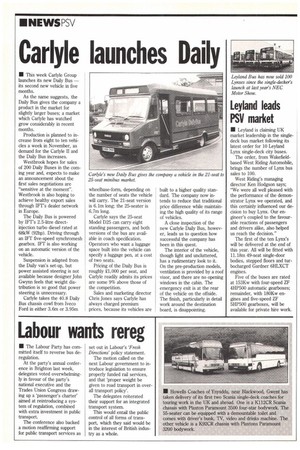Carlyle launches Daily
Page 20

If you've noticed an error in this article please click here to report it so we can fix it.
• This week Carlyle Group launches its new Daily Bus — its second new vehicle in five months.
As the name suggests, the Daily Bus gives the company a product in the market for slightly larger buses; a market which Carlyle has watched grow considerably in recent months.
Production is planned to increase from eight to ten vehicles a week in November, as demand for the Carlyle II and the Daily Bus increases.
Westbrook hopes for sales of 200 Daily Buses in the coming year and, expects to make an announcement about the first sales negotiations are "sensitive at the moment". Westbrook is also hoping to achieve healthy export sales through IFT's dealer network in Europe.
The Daily Bus is powered by IFT's 2.5-litre directinjection turbo diesel rated at 68kW (92hp). Driving through an IFT five-speed synchromesh gearbox. IFT is also working on an automatic version of the vehicle.
Suspension is adapted from the Daily van's set-up, but power assisted steering is not available because designer John Gwynn feels that weight distribution is so good that power steering is unnecessary.
Carlyle takes the 40.8 Daily Bus chassis cowl from Iveco Ford in either 3.6m or 3.95m I wheelbase-form, depending on the number of seats the vehicle will carry. The 21-seat version is 6.1m long, the 25-seater is 6.7m long.
Carlyle says the 25-seat Model D25 can carry eight standing passengers, and both versions of the bus are available in coach specification. Operators who want a luggage space built into the vehicle can specify a luggage pen, at a cost of two seats.
Pricing of the Daily Bus is roughly £1,000 per seat, and Carlyle readily admits its prices are some 9% above those of the competition.
Sales and marketing director Chris Jones says Carlyle has always charged premium prices, because its vehicles are built to a higher quality standard. The company now intends to reduce that traditional price difference while maintaining the high quality of its range of vehicles.
A close inspection of the new Carlyle Daily Bus, however, leads us to question how successful the company has been in this quest.
The interior of the vehicle, though light and uncluttered, has a rudimentary look to it. On the pre-production models, ventilation is provided by a roof visor, and there are no opening windows in the cabin. The emergency exit is at the rear of the vehicle on the offside. The finish, particularly in detail work around the destination board, is disappointing.
























































































































